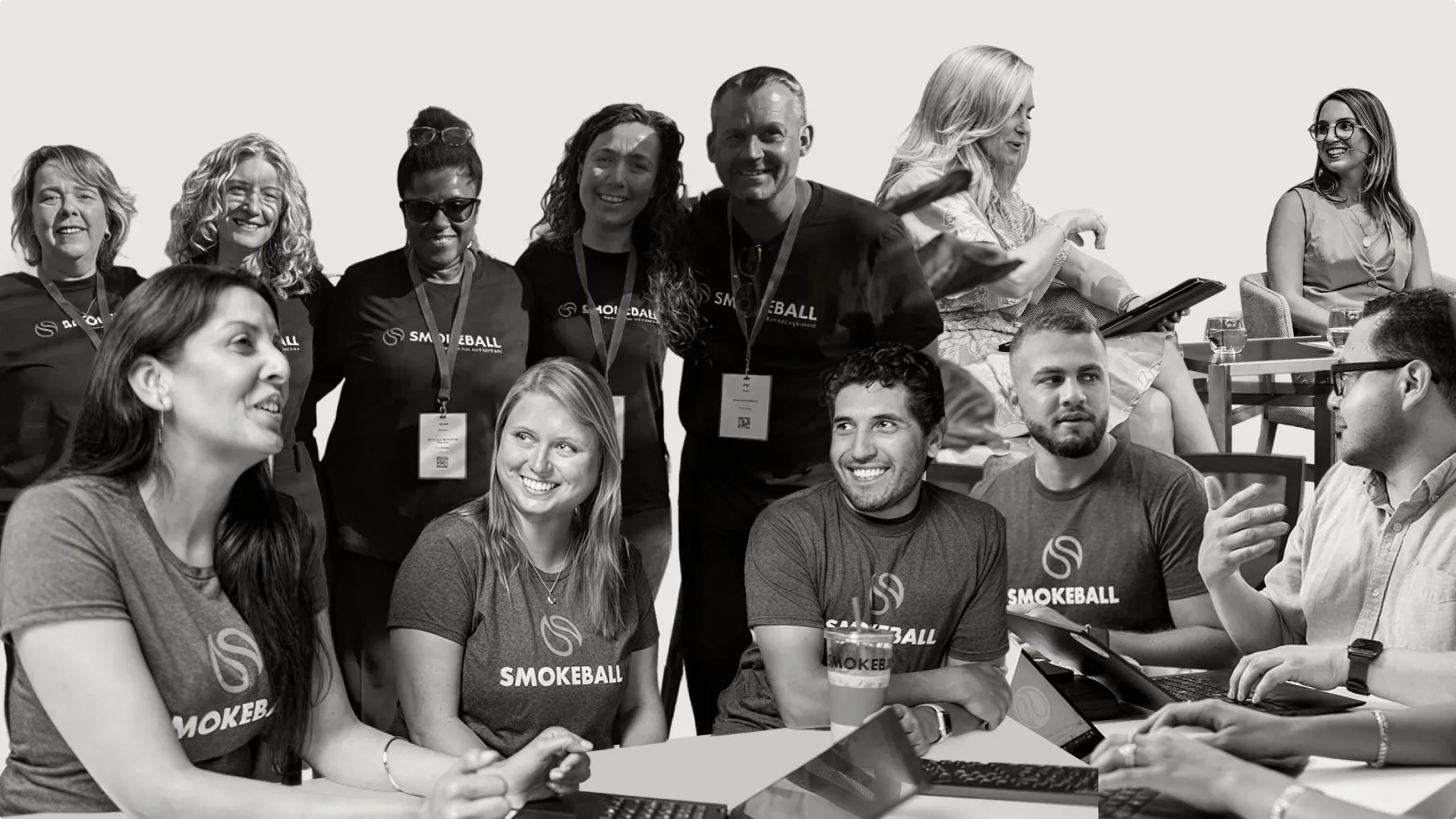Scaling customer centricity
How Smokeball created a unified customer intelligence system across continents
Insights from

Smokeball
Cloud-based legal practice management software enhanced with AI.

Adele Hoyle
Chief Product Officer

Emma Erlach
Head of Product Strategy

About Smokeball
Integrations used
Twine call bot
Record and identify key moments from your calls
Salesforce
Link issues to affected deals for revenue-driven decisions
Slack
Reports and clips delivered where your teams already work
Impact
The documentation paradox
For Smokeball, the irony wasn’t lost on them. Their software helps law firms streamline operations and eliminate inefficiencies, yet internally, their own customer insights were trapped in a web of disconnected tools and manual processes.
“We spend our whole day solving problems for our customers, and yet we have our own problems with lots of different data and systems that don’t talk to each other nicely,” explains Adele Hoyle, Chief Product Officer at Smokeball. “This is the exact problem we solve for our customers every day, but we were living with it ourselves.”
This contradiction became more acute as Smokeball expanded globally. With a customer-centric culture at their core, their teams were constantly engaging with customers, generating valuable insights that couldn’t be efficiently captured or shared.
“We’re a very customer-centric, product-led organization and we talk to our customers all the time. That’s what we love to do. That’s what makes us so successful,” notes Adele. “But there was actually no single place where we could capture all the really juicy goodness from those calls.”
When connection becomes complexity
The pain was felt across every level of the organization. Product managers were spending hours each week manually documenting conversations in Confluence. Client Success teams were transcribing entire calls and then using ChatGPT to summarize them. Engineers were receiving filtered interpretations of customer needs rather than hearing customer voices directly.
Emma Erlach, Head of Product Strategy, describes the tedious process: “Every week for me was writing notes in Confluence, which was pretty time-consuming, and then trawling through Zendesk, trying to understand what the themes were coming through from our support team.”
The challenge intensified when Smokeball expanded to the UK. Without dedicated product resources in this new market, the team faced the impossible choice between frequent international travel or accepting an incomplete understanding of their UK customers’ needs.
What’s more, whenever customer feedback did make it through these barriers, it often arrived distorted. “Every time we would get insights from sales and CS teams, it was full of bias, full of emotion, and just really difficult to ever use in what we were doing,” Adele explains.
Autonomous teams, automated intelligence
When Smokeball implemented Twine, they expected to solve their documentation challenges. What they didn’t anticipate was how it would transform their entire organizational dynamic.
“We’ve built these autonomous squads with a product manager and engineers who are passionate about solving problems in specific spaces,” Adele shares. “Previous to Twine, it was always the product manager telling the engineers what to do, and it became ‘product said this and product said that.’ Now we’ve got the reports going into every squad Slack channel, and the engineers are loving the information coming directly to them.”
This direct connection to customer feedback created a fundamental shift. Instead of product managers interpreting customer needs, engineers began connecting directly with customer problems and proposing solutions themselves.
“I’m just seeing the conversations within teams already improving because it’s not about what product is telling them to do—it’s about understanding the customer. Now engineers are going to product managers saying ‘we should work on this area, we could solve this problem in this way.’”
The impact wasn’t limited to the product organization. Client Success teams, who previously spent time transcribing calls and generating summaries with ChatGPT, now had Twine handling this automatically. “The CSMs completely cut out that middle step and they just love it,” Emma notes. “So much so that the sales team is now asking when they can get Twine.”
The virtual product presence
For Smokeball’s global expansion, Twine solved a particularly pressing challenge—how to maintain product presence in markets without dedicated product resources.
“We don’t have any product presence in the UK; it’s just operational teams,” explains Adele. “I meet with the UK team every week to talk about their insights, but I hear it from this biased, empathetic, emotional lens. We started to realize we weren’t quite speaking the same language.”
The solution? “Let’s get you all using Twine. Now I’m hearing firsthand what your customers are saying without having to keep sending myself or product team members to the UK, which is not scalable.”
This virtual product presence has eliminated the gap between different markets, ensuring that customer voices from Australia, the US, and the UK all receive equal consideration in product decisions.
“I literally just sent a PM there again because I’ve been a couple of times, she’s now been a couple of times, and I’m like ‘we can’t keep doing this, this is crazy and expensive.’ And I’m like, ‘I can do this. He’s your PM—Twine is your product manager here.’”
Real people, real problems, real solutions
The transformation extended beyond efficiency gains to fundamentally changing how the entire organization connects with customer needs. Company presentations now feature real customer quotes captured by Twine, creating stronger emotional connections to the problems they’re solving.
“Previously we’d be talking about the problems we’re focusing on and when features would be available. Now we’re using real people with real intel from Twine. We put it on a slide to say, ‘this person works at this law firm, has this problem, and this is the quote we got from them.’”
This approach has garnered positive feedback throughout the organization. “People have given us so much positive feedback about taking it back down to the problem, which we were talking about before, but we’ve elevated it so much more now because we’re using real people and real intel.”
From reactive to proactive
Perhaps most importantly, Twine has transformed how Smokeball identifies and addresses customer issues. Rather than waiting for problems to escalate, teams can now proactively identify and solve issues before they impact customer satisfaction.
“When we see something comes up in a Twine as a piece of negative product feedback, the team jumps straight on it. In some cases, we’ve found the team weren’t aware of a new feature that would solve that problem. So the recording gets sent to that product team, they watch it and go, ‘Oh, we can do that, we can solve that.’”
This creates a virtuous cycle where Client Success teams immediately relay solutions back to customers, turning negative feedback into positive experiences. “The Client Success team loves that we’re helping them so quickly and understanding problems we didn’t even know customers were having, actually turning negative feedback into positive feedback.”
The AI launch advantage
The implementation of Twine proved particularly valuable during the launch of Smokeball’s AI assistant, Archie. By having Twine in place at launch, the team could capture detailed feedback about this major new feature from day one.
“When we launched our AI assistant named Archie, we started using Twine at exactly the same time,” recalls Emma. “We’re getting way more insights than we had before because of the Twine recordings, and what’s been great is a lot of the feedback we’re seeing is validating what we were hearing before.”
This immediate feedback loop has helped the team refine and improve Archie quickly, while also providing validation that they’re on the right track. Even the CEO has become a direct consumer of these insights.
“Previously it was just me and the CEO trying to think about new ideas to improve Archie. Now the intel’s going straight to him, and he’s constantly looking at, ‘Oh yeah, see the customer said they wanted this, we’re doing this.’ He can hear it himself, which is great.”
A sustainable system for scaling
For Smokeball, Twine has become essential infrastructure for maintaining customer centricity while scaling efficiently. Their advice to other product leaders facing similar challenges is straightforward:
“Invest in yourself, invest in your teams,” urges Adele. “I think it’s a pretty cheap investment given the amount of time savings it will have. And naturally, the value of this product only grows over time.”
The Smokeball team continues to find new use cases for Twine, from coaching customer-facing teams to identifying opportunities to improve existing integrations. As Emma puts it: “We’re still getting new value out of this every week, and we’ve only been using it a short time. We’re excited about what else we’re going to discover.”
“It takes the opinion and the anecdote out of everything. Now we can very easily back our decisions with insights we’ve got from Twine. It’s all about data—being able to support everything we’re doing, not just because we think it’s a good idea, but because we’re hearing the problem and have the evidence to support it.” - Emma Erlach
Want to learn how Twine can help your product team make better decisions? Book a demo.
About Smokeball
Integrations used
Twine call bot
Record and identify key moments from your calls
Salesforce
Link issues to affected deals for revenue-driven decisions
Slack
Reports and clips delivered where your teams already work
